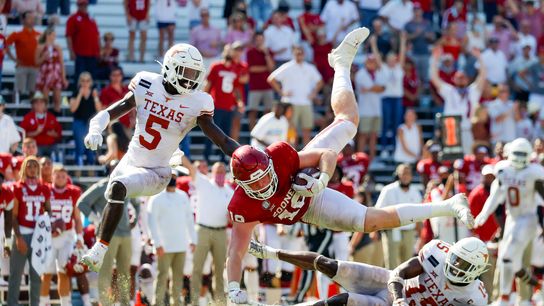The Big 12 isn't letting its two marquee members leave for the SEC without a fight, because of course it isn't. What's the alternative, surrender to oblivion?
This conference, an arranged marriage of two dying leagues some 25 years ago, has survived dances with death twice, and now here it is a third time.
After an all-hands meeting that did not include Texas and Oklahoma last week, commissioner Bob Bowlsby, Texas Tech president Lawrence Shovanec and Baylor president Linda Livingstone met with their Red River counterparts (Joe Harroz, OU; Jay Hartzell, UT) where they "expressed a willingness to discuss proposals that would strengthen the conference and be mutually beneficial to OU and UT, as well as the other member institutions of the conference," according to Bowlsby.
"I expect that we will continue our conversations in the days ahead and we look forward to discussing thoughts, ideas and concepts that may be of shared interest and impact," Bowlsby said.
Is there an alternative arrangement that would leave the Big 12 intact and the Big 2 filthy, stinky rich? Sure there is. In fact, the Red River rivals could conceivably stay put and find themselves filthier and stinkier than they'd be even as SEC members.
Think about it: Projections say an SEC with Texas and Oklahoma would quickly see a conference payout climb from around $45 million per school to north of $60. Well, Dennis Dodd reported for CBS Sports that the league has discussed giving each school 1.5 shares, meaning they'd earn around $56 million per -- on top of third-tier rights that they get to keep as Big 12 members. UT's deal with ESPN for the Longhorn Network pays eight figures annually.
But let's take it further than that. Big 12 schools took home around $37 million apiece last year. What if the other eight schools promised Big 2 half? We'd be talking north of $90 million per school, per year, plus third-tier rights. No other league can even approach to that number, not even the big, bad SEC. Sure, that'd mean a massive pay cut for the Remaining 8 -- my iPhone calculator math tells me their payouts would drop from $37 million to around $23 million.
But think about it, all of the Remaining 8 have done their own due diligence on what life could look like in the very near future, and maybe they don't like what they've heard. Maybe the Pac-12 isn't interested. Maybe ESPN has floated a figure of what the Remaining 8 plus (insert G5 schools here) are worth and it's less than $23 million. Maybe the American has even gone on the offensive and their number doesn't touch $23 million. Perhaps a 50/50 revenue split -- really, a 25/25/6.25 split, on a per school basis -- doesn't sound so bad now.
A 50/50 split is an extreme example to be sure, but what other choice do the Remaining 8 have? If you're Texas Tech or Baylor, even if the Pac-12 are interested, don't you prefer life in the Big 12, life as you thought it was until Wednesday afternoon, anyway? Annual games with Arizona and Utah can't compete with annual games with Texas and OU.
Here's the thing, though. If you're OU and Texas, the horse is out of the barn. He's not just out of the barn, he's off the farm and trotting down the highway.
For these schools, this move isn't just about money. It's largely about money, yes, but it's also about prestige, about a statement of intent. The Remaining 8 and the folks in the conference office can surely put together an enticing offer on paper, but recruits don't care. Fans don't care. This is about recruiting on a level playing field, about moving to a neighborhood where you're not the only house with two Mercedes and a boat on the driveway... while also getting rich.
The Red River rivals have walked their respective communities down this road before, remember. In 2010, Texas and OU (along with Tech, OK State, A&M and Colorado) were out the door for the Pac-12. Gone. It was done. Until it wasn't.
They got a better deal out of the Big 12 then, too. What did it get them? Oklahoma got lots of conference championships and Playoff appearances, sure, and Texas got... money. Now here they are, 11 years later, on the brink of leaving again.
This Sunday night Zoom goes one of two ways:
Either it's an awkward formality Harroz and Hartzell had to go through, no different than any other breakup where one party has moved on and the other is still in love. Or this whole SEC dalliance really was just a ploy to get a better deal out of the Big 12 and their TV partners (remember OU's shot at Fox?) and both schools are in for a Red River Revolt.
Monday update> OU & Texas have issued the following statement:
